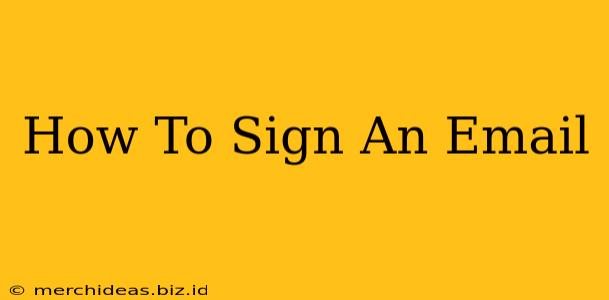Choosing the right email signature is crucial for making a strong and professional impression. Your email sign-off is the final touch, leaving a lasting impression on your recipient. Whether you're emailing a client, colleague, or friend, a well-crafted email signature conveys professionalism and personality. This guide will explore various email closing options to help you choose the best fit for every situation.
Understanding the Importance of Email Signatures
Your email signature is more than just your name and contact information. It's a powerful tool for:
- Branding: A consistent signature reinforces your personal or company brand.
- Professionalism: A well-designed signature showcases your attention to detail.
- Contact Information: It makes it easy for recipients to connect with you.
- Call to Action (CTA): You can subtly guide recipients to your website or social media.
Choosing the Right Email Closing: A Guide
The best email closing depends heavily on your relationship with the recipient and the context of the email. Here's a breakdown of suitable options:
Formal Email Closings:
- Sincerely: A classic and universally appropriate choice for formal emails. It conveys respect and professionalism.
- Respectfully: Suitable when addressing someone of higher authority or in a formal business setting.
- Regards: A more concise and slightly less formal alternative to "Sincerely."
- Cordially: Expresses warmth and professionalism, suitable for business emails.
Semi-Formal Email Closings:
- Best regards: A common and versatile choice that works well in many professional situations.
- Kind regards: Expresses friendliness and respect, suitable for both professional and personal emails.
- Warmly: Conveys a warmer, more personal tone, appropriate for emails to people you know reasonably well.
Informal Email Closings:
- Best: A casual and friendly choice for emails to close friends, family, or colleagues you're close to.
- Cheers: A more informal and upbeat closing, suitable for emails to colleagues or friends.
- Thanks: Appropriate when you're expressing gratitude in your email.
- Talk soon: Suitable for emails to close friends, family or colleagues suggesting future interaction.
What to Include in Your Email Signature
Beyond the closing itself, your email signature should include:
- Your Full Name: Clearly display your name and title.
- Your Contact Information: Include your phone number and email address.
- Your Company (if applicable): This adds context and professionalism.
- Your Website/Social Media Links (optional): Include relevant links to your professional online presence, but be mindful not to clutter your signature.
Avoiding Email Signature Mistakes
- Overly long signatures: Keep it concise and easy to read.
- Inappropriate images or graphics: Stick to professional and relevant visuals.
- Inconsistent branding: Ensure your signature reflects your overall branding.
- Missing crucial contact information: Make it easy for people to reach you.
Crafting the Perfect Email Signature
By following these guidelines, you can craft an email signature that reflects your professionalism and enhances your communication. Remember to choose the closing and content that best suits the context and recipient. A well-crafted email signature leaves a positive lasting impression, contributing to effective and professional communication.
